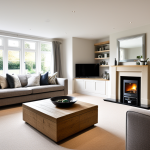Actionable Strategies for Improving UK Home Comfort
Improving UK home comfort starts with understanding local climate challenges. The UK’s often damp and chilly weather demands solutions focused on warmth and dryness. Simple changes like adding draught excluders or upgrading to double-glazed windows can yield immediate comfort boosts without large expenses.
For quick wins, rearranging furniture to allow heat circulation or using heavy curtains to retain warmth are practical tips. These interventions address common issues like cold spots and heat loss, which many UK homes face.
Have you seen this : How Can Integrated Technology Transform Your Everyday Home Experience?
Balancing aesthetics with functionality is essential. While creating a welcoming atmosphere, opt for finishes and fabrics that also improve insulation and durability. For example, textured cushions and rugs not only add to the visual appeal but contribute to maintaining cosy living environments.
Living space improvement in UK homes often benefits from multi-purpose solutions. Integrating storage with seating or using versatile lighting setups enhances comfort while fitting modern lifestyles. These strategies combine design sense with practical benefits, ensuring homes feel both stylish and snug throughout the year.
Topic to read : How Can You Enhance the Comfort of Your Home with Simple Decor Changes?
Furniture Choices for Enhanced Relaxation and Functionality
Choosing comfortable furniture UK residents value is central to living space improvement. Sofas and chairs should prioritise durability without compromising on softness. Look for materials that withstand the UK’s moisture-prone climate yet feel inviting. For example, treated leather or tightly woven fabrics offer resilience and cosy textures.
In smaller UK homes, multi-functional furniture plays a pivotal role. Pieces like sofa beds, ottomans with storage, or extendable dining tables optimise limited space while enhancing comfort. This approach balances practicality with style, making everyday living more enjoyable.
Current British interior trends favour neutral tones paired with cosy elements such as plush cushions and throws. These design choices blend comfort and aesthetics seamlessly. Opting for such furniture supports both relaxation needs and the modern desire for elegant, uncluttered spaces.
By selecting furniture carefully with the UK’s climate and space challenges in mind, you enhance both the functional and restful qualities of your living areas. This method ensures your home feels welcoming, stylish, and tailored to daily comfort demands.
Actionable Strategies for Improving UK Home Comfort
Improving UK home comfort means addressing local climate challenges head-on. The UK’s damp and chilly conditions require solutions that maintain warmth and prevent moisture buildup. Simple, effective comfort tips include installing draught excluders around doors and windows, which seal gaps to reduce heat loss. Upgrading to double-glazed windows is another key step, significantly enhancing insulation.
For immediate improvements, rearranging furniture to unblock heat sources ensures better circulation, while adding heavy curtains helps trap warmth. These small changes can drastically improve living environments without major renovations.
Balancing aesthetics with functionality enhances the overall living space improvement experience. For example, opting for insulating curtains that complement your décor blends warmth retention with style. Similarly, rugs with textured fibres add both visual interest and insulation against cold floors.
Understanding UK-specific needs ensures upgrades are practical and effective. Prioritise solutions that resist moisture and retain heat. Remember, comfort isn’t just about warmth—it also includes creating an inviting atmosphere suited to everyday life in Britain’s unique climate.
Actionable Strategies for Improving UK Home Comfort
Achieving UK home comfort hinges on solutions tailored to local climate challenges. The damp and cool conditions require targeted steps to maintain warmth without encouraging moisture buildup. Among effective comfort tips, sealing drafts with draught excluders reduces heat loss significantly. Upgrading windows to double-glazing provides lasting insulation benefits.
For quick wins, rearranging furniture to ensure unobstructed heat circulation improves warmth distribution instantly. Adding heavy, insulating curtains traps heat near windows, limiting chills from cold surfaces. These changes need minimal effort but greatly enhance living space quality.
Balancing aesthetics with functionality means choosing upgrades that complement your décor while boosting comfort. For example, rugs with thick textures add insulation and visual interest simultaneously. Opting for place-worthy cushions or throws in insulating fabrics supports warmth and style seamlessly.
Addressing the UK’s specific climate demands by combining pragmatic and stylish choices ensures homes remain cosy year-round. Applying these actionable strategies in your living spaces promotes comfort without sacrificing design, producing an inviting environment suited to everyday British life.
Actionable Strategies for Improving UK Home Comfort
Enhancing UK home comfort requires practical approaches sensitive to local climate challenges. Quick wins often involve simple changes for immediate results. For example, sealing door and window gaps with draught excluders dramatically reduces heat loss while being cost-effective. Rearranging furniture to allow efficient heat circulation can also improve warmth without extra expense.
Considering UK-specific home challenges, moisture control is vital. Solutions that trap heat but avoid damp buildup ensure a healthier environment. Choosing heavy, insulating curtains helps retain warmth near cold windows, addressing chill without compromising aesthetics.
Balancing aesthetics with functionality means selecting items that serve comfort needs while complementing décor. Thick textured rugs and cushions can add visual warmth and improve insulation simultaneously. Opt for fabrics and finishes that endure the UK’s often damp conditions, blending style with durability.
Implementing these comfort tips leads to meaningful living space improvement. Practical yet stylish upgrades create cosy, inviting homes suited to British weather, enhancing wellbeing without extensive renovation.
Actionable Strategies for Improving UK Home Comfort
Enhancing UK home comfort effectively means focusing on quick wins that tackle local climate challenges. Sealing drafts with draught excluders is one of the most impactful comfort tips; it prevents heat escaping, which is crucial for the UK’s damp and chilly conditions. Rearranging furniture to promote better heat circulation maximises the efficiency of existing heating, improving room warmth instantly.
Consider the UK’s specific moisture and temperature issues when selecting upgrades. Heavy, insulating curtains reduce cold drafts from windows while maintaining aesthetic value. Similarly, adding thick rugs with texture offers both visual warmth and insulation against chilly floors, enhancing living space improvement with style.
Balancing functionality and design is key. Choose upgrades that improve comfort but also complement décor so your home remains inviting and practical. For example, opting for fabrics resistant to dampness or incorporating decorative cushions improves warmth and resilience seamlessly. By focusing on these practical yet stylish strategies, you ensure your home stays cosy and attractive throughout the year, suited perfectly to British climate demands.
Actionable Strategies for Improving UK Home Comfort
Achieving UK home comfort quickly often means focusing on small yet effective changes. Among the best comfort tips are sealing drafts with draught excluders. This simple fix minimizes heat loss and combats the UK’s persistent chill effectively. Rearranging furniture to promote optimal heat flow from radiators or fireplaces also provides immediate warmth improvement.
The UK’s damp and often unpredictable climate demands careful living space improvement choices. It’s crucial to balance warmth retention with moisture control to prevent dampness. Heavy, insulating curtains trap heat near windows, reducing cold drafts while adding style. Similarly, layered rugs with dense textures shield floors from the cold and introduce visual interest.
Functionality and aesthetics should coexist in comfort upgrades. Choose materials that resist moisture and wear while fitting your décor preferences. For example, fabric selections that repel dampness or finishes that withstand humidity can keep interiors appealing and resilient. Integrating these practical yet stylish solutions ensures homes stay cosy, healthy, and inviting throughout the year, aligning with the unique needs of UK homes.
Actionable Strategies for Improving UK Home Comfort
To enhance UK home comfort effectively, focus on quick wins that tame the local damp and chilly climate. Sealing drafts with draught excluders is a top comfort tip, as it drastically reduces heat loss, addressing one of the main causes of discomfort in British homes. Rearranging furniture to allow unobstructed heat flow from radiators or fireplaces further boosts warmth distribution, creating a more even and inviting temperature.
Considering the UK’s moisture challenges is vital for lasting living space improvement. Heavy, insulating curtains trap heat near cold windows while limiting damp buildup, thus balancing warmth retention with breathability. Similarly, thick textured rugs add both visual warmth and insulation against chilly floors.
Balancing functionality with style elevates comfort upgrades. Opt for fabrics and furnishings resistant to moisture and wear, ensuring durability without sacrificing aesthetic appeal. For instance, cushions and throws made from insulating, damp-resistant materials enhance coziness and blend seamlessly with décor.
By combining these comfort tips—draft prevention, heat optimisation, moisture management, and stylish insulation—you achieve a cosy, practical living space perfectly suited to the UK’s distinctive climate demands.







